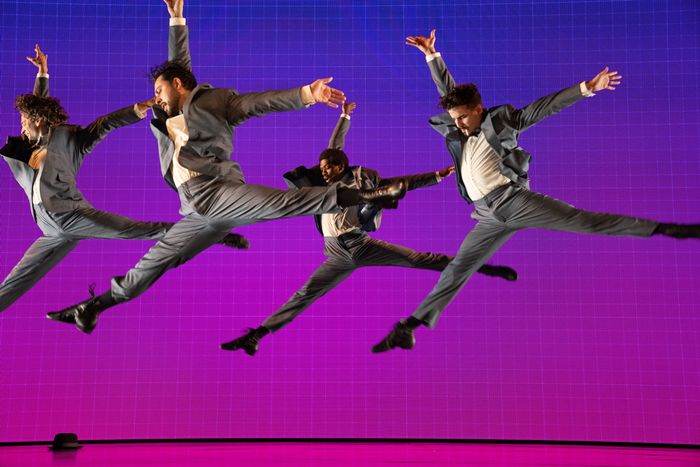
If you’ve gotten the feeling that sex is missing from your entertainment, that you’ve seen one too many neutered superhero movies or buttoned-up but still violent television, let me recommend that you shimmy-shake over to Dancin’. The revival of the 1978 Bob Fosse revue is eager to seduce you. Skintight outfits, sultry postures, cigarette smoking, cocked hats, and an egalitarian air of come-one-come-all hedonism: This is a show hell-bent on making sure that you have fun, laughs, good times at any cost. True to Fosse’s style, it’ll do anything to please.
To that end, Dancin’ immediately abandons any pretense to a plot. Manuel Herrera, one of several dancers who plays a Fosse stand-in figure over the course of the show, enters with a hat and a wisecrack, announcing that “the viewing of too many musical comedies with sentimental and overromantic plots may cause serious and sometimes incurable damage to the playgoer and the critics’ standards.” What follows is a series of loosely connected dance-based vignettes, all with the signature Fosse elements: the thrown-back shoulders, the isolated motions of the hands and feet, actions that lead with the hips, making everyone move like a marionette piloted by a randy, inebriated puppeteer. Apart from showcasing the steps themselves, Dancin’ also provides a survey of Fosse’s thematic obsessions — seduction, yes, but also showmanship and clowning. Early on, “Mr. Bojangles,” with a recorded voice-over introduction from Fosse himself about his love of and identification with Bill Robinson, sets a rueful tone. So does a recurring emphasis on the wear and tear on dancers’ bodies and their psychology, that willful, delighted self-immolation. The group performance of “Dancin’ Man,” serving as the Act One finale, makes it all explicit. “I wanna be a dancin’ man,” the ensemble sings, “while I can.” Come, let us entertain you, the subtext goes, as we all lurch toward oblivion and hip-flexor injuries.
Wayne Cilento, director of this revival, danced in the original Dancin’ and has pieced together a new version of the show, pared it down to two acts, and incorporated pieces of other Fosse works. Partially that’s because there isn’t much video of the first run, and in addition to drawing on dancers’ memories, the creative team worked off “grainy film from a Japanese touring production” to reconstruct it. The additions include a cut-from-the-original “Big City Mime” sequence, in which a naïve newcomer to New York, played by the swanlike Peter John Chursin, discovers the depravity of the big city, which is full of strip clubs, bordellos, and even a very horny bookstore. Cilento, reassembling that sequence, has filled it with quotes from Fosse’s most famous dances, including the strutting upon chairs from “Mein Herr,” the louche group come-hither of “Hey Big Spender,” and the flamingo pecking of the “Rich Man’s Frug.” There’s also winking, Fosse-esque humor: Medieval soldiers come out and dance in the background of the bookstore encounter — because Dylis Croman’s character has suggested a book on Charlemagne — and the sequence builds to a performance by Spring Chicken, a nightclub performer played by Kolton Krouse who falls somewhere between Sally Bowles and Frank-N-Furter. Later on, in Act Two, Cilento also inserts selections from Fosse’s last show, 1986’s Big Deal, in which Cilento also appeared. It’s a gangster pastiche set to music from the 1920s and ’30s — Khori Michelle Petinaud, in addition to being a statuesque dancer, proves she has a theater-rattling voice with “Life Is Just a Bowl of Cherries” — though it’s harder to latch into another narrative sequence so late in the show. You get a sense of Big Deal as a curio with some showstopping ideas, like a suspender-stretching dance set to “Beat Me Daddy, Eight to the Bar,” that couldn’t come together as a whole.
Part of the fun of Dancin’, however, is the way it pairs with the Fosse/Verdon TV series, giving you a portrait into the director’s psychology through his work. (Fosse’s daughter Nicole is involved in both productions.) A little trip down the rabbit hole after seeing them very quickly reveals telling anecdotes. Sam Wasson’s biography reveals that during the development of the show, Fosse’s muse Ann Reinking fell for fellow dancer Charles Ward, so Fosse made Ward’s solo, “Ionisation,” progressively more and more difficult out of cuckolded jealousy/retribution/respect. (The biography also notes that many dancers were doing a lot of cocaine to get through the show, which tracks.) As Ron Todorowski takes on that “Ionisation” sequence in the Dancin’ revival, you can feel the plasma of Fosse’s emotions flowing through it. In close-cut and revealing red, Todorowski becomes both a Greek god showing off for us mortals and a human being desperately doing whatever he can to win your approval. Fosse’s work is charged by this love of and cruelty toward the dancer’s body. He feels for it and wants to push it to its extreme.
Dancin’, as revived and revised, softens that edge while remaining charged. The new lineup is intentionally more inclusive and edits some of Fosse’s inherent chauvinism. The dancers of the “Female Star Spot” complain about the lyrics of Dolly Parton’s “Here You Come Again,” and Krouse, who is nonbinary, takes on Reinking’s iconic nothing-but-legs “Trumpet Solo.” But this is still a show about pushing the body hard, and the cast of Dancin’ obviously relishes that challenge. All the ensemble members stand out in their own ways, giving personality to their specific solos, taking individual closing bows. By then, they all look thrilled and exhausted, admirable and vulnerable. That’s part of the seduction: They’re pushing themselves to their limits in the name of a good show. The ethos throws you back to an earlier era of Broadway, to something a little more sinewy and id-driven than your typical family-friendly movie-adaptation musical. It’s almost disappointing to exit afterward into a Times Square that isn’t full of graffiti and porno theaters.
Dancin’ is at the Music Box Theatre.


